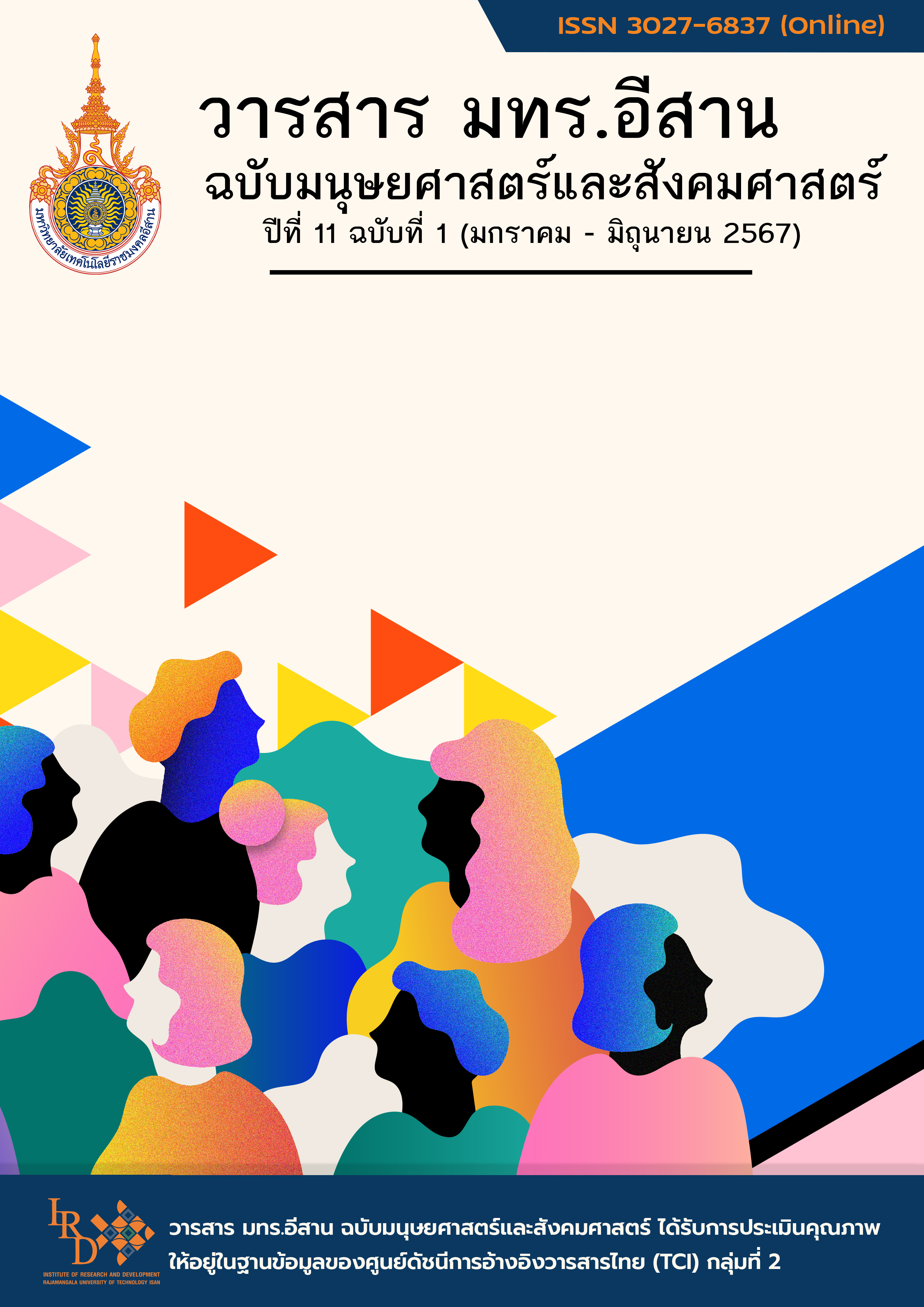The Relationship Between Work Passion and Job Performance of Employees in Manufacturing Industry Plants
Main Article Content
Abstract
This research is a quantitative study using a survey method, with the objectives of 1) investigating the work passion of employees in manufacturing industry plants, 2) examining the efficiency of work among employees in manufacturing industry plants, and 3) investigating the relationship between employees' dedication and commitment to work and the performance effectiveness in the manufacturing industry 3) studying the relationship between gender, age, educational level, income, harmonious passion, and obsessive passion with the job performance of employees in the manufacturing industry. The researcher used a questionnaire to collect data from employees in manufacturing plants in the Bangkok metropolitan and suburban areas, with a total of 400 participants. The Stratified Random Sampling method was employed, dividing the sample by province. Subsequently, the distribution was based on the population proportions within each province, followed by purposive sampling, resulting in the retrieval of 400 questionnaires, representing a response rate of 100 percent. The research findings indicate that: 1) Overall, employees exhibit a high level of work passion, with both harmonious passion and obsessive passion being at the highest levels. 3) The job performance of employees is found to be at the highest level. 4) The statistical analysis reveals significant correlations between personal factors and work passion. In particular, harmonious passion and obsessive passion significantly impact the job performance of employees in manufacturing industry plants at a significance level of 0.05. However, personal factors do not have a significant impact on job performance. The industrial manufacturing factory can establish systems and mechanisms to promote dedication and work passion among employees. This can lead to increased productivity and effectiveness in the workplace, ultimately contributing to the factory's competitiveness and profitability.
Article Details

This work is licensed under a Creative Commons Attribution-NonCommercial-NoDerivatives 4.0 International License.
บทความที่ได้รับการตีพิมพ์เป็นลิขสิทธิ์ของมหาวิทยาลัยเทคโนโลยีราชมงคลอีสาน
ข้อความที่ปรากฏในบทความแต่ละเรื่องในวารสารวิชาการเล่มนี้เป็นความคิดเห็นส่วนตัวของผู้เขียนแต่ละท่านไม่เกี่ยวข้องกับมหาวิทยาลัยเทคโนโลยีราชมงคลอีสานและคณาจารย์ท่านอื่นๆในมหาวิทยาลัยฯ แต่อย่างใด ความรับผิดชอบองค์ประกอบทั้งหมดของบทความแต่ละเรื่องเป็นของผู้เขียนแต่ละท่าน หากมีความผิดพลาดใดๆ ผู้เขียนแต่ละท่านจะรับผิดชอบบทความของตนเองแต่ผู้เดียว
References
กรมโรงงานอุตสาหกรรม. (2565). สถิติโรงงานอุตสาหกรรม. เข้าถึงเมื่อ (20 เมษายน 2566). เข้าถึงได้จาก (https://www.diw.go.th/webdiw/static-fac/)
กัลยา วานิชย์บัญชา และฐิตา วานิชย์บัญชา. (2558). การใช้ SPSS for Windows ในการวิเคราะห์ข้อมูล. กรุงเทพฯ: จุฬาลงกรณ์มหาวิทยาลัย
กัลยา วานิชย์บัญชา. (2548). สถิติสำหรับงานวิจัย. กรุงเทพฯ: โรงพิมพ์แห่งจุฬาลงกรณ์มหาวิทยาลัย
นัทพร ศรีบุญรอด. (2552). ความสัมพันธ์ระหว่างการรับรู้การสนับสนุนจากหัวหน้างานและผลการปฏิบัติงานโดยมีการรับรู้การสนับสนุนจากองค์การเป็นตัวแปรสื่อ. กรุงเทพฯ: โรงพิมพ์แห่งจุฬาลงกรณ์มหาวิทยาลัย
ปพิชญา ศรีจันทรา. (2563). แรงจูงใจและประสิทธิผลการปฏิบัติงานของบริษัทขนส่งแห่งหนึ่งในเขตกรุงเทพมหานคร. กรุงเทพฯ: มหาวิทยาลัยศรีนครินทรวิโรฒ
ปุญญิศา สังคจิตต์. (2561). ปัจจัยที่มีอิทธิพลต่อความทุ่มเทในการทำงานของพนักงานเจเนอเรชั่นวาย กรณีศึกษาการไฟฟ้าฝ่ายผลิตแห่งประเทศไทยสำนักงานใหญ่ สำนักงานใหญ่. สงขลา: มหาวิทยาลัยสงขลานครินทร์
พิชญาภา วงศ์หมัดทอง. (2563). ภาวะผู้นำการเปลี่ยนแปลงที่ส่งผลกระทบต่อความมุ่งมั่นทุ่มเทในการทำงาน กรณีศึกษา บุคลากรโรงพยาบาลสงขลา. สงขลา: มหาวิทยาลัยสงขลานครินทร์
ภคภัค สังขะสุนทร และวาสิตา บุญสาธร. (2558). ปัจจัยที่ทำให้เกิดความมุ่งมั่นและพลังขับเคลื่อนในวิชาชีพบุคคล: กรณีศึกษาบริษัทปูนซีเมนต์ไทย จำกัด (มหาชน). วารสารการพัฒนาทรัพยากรมนุษย์และองค์การ. ปีที่ 7 ฉบับที่ 2 หน้า 43-69
มานิดา เขียวอ่อน (มปป.). ปัจจัยที่ส่งผลต่อประสิทธิผลการทำงานของพนักงานระดับปฏิบัติการบริษัทแห่งหนึ่ง. เข้าถึงเมื่อ (28 มกราคม 2566). เข้าถึงได้จาก (https://mmm.ru.ac.th/MMM/IS/vlt13-1/sec1/6014993016.pdf)
สุนทร เสงี่ยมพงษ์. (2559). ประสิทธิผลในการปฏิบัติงาน : กรณีศึกษา พนักงานฝ่ายปฏิบัติการเสาโทรคมนาคมบริษัททีโอที จํากัด (มหาชน). กรุงเทพฯ: มหาวิทยาลัยเกริก
สุภารัตน์ กุลโชติ. (2566). แรงจูงใจที่ส่งผลต่อประสิทธิผลในการปฏิบัติงานของบุคลากร สังกัดเทศบาลนครหาดใหญ่จังหวัดสงขลา. สงขลา: มหาวิทยาลัยสงขลานครินทร์
Bovee, C. L., Thill, J. V., Wood, M. B., and Dovel, G. P. (1993). Management. New York: McGraw-Hill, Inc
Ho, V. T., Wong, S. -S., and Lee, C. H. (2011). A Tale of Passion: Linking Job Passion and Cognitive Engagement to Employee Work Performance. Journal of Management Studies. Vol. 48 Issue 1 pp. 26-47. DOI: 10.1111/j.1467-6486.2009.00878.x
Pollack, J., Ho, V., O'Boyle, E., and Kirkman, B. (2020). Passion at Work: A Meta-Analysis of Individual Work Outcomes. Journal of Organizational Behavior. Vol. 41 Issue 4 pp. 311-331. DOI: 10.1002/job.2434
The Ken Blanchard Companies. (2013). EMPLOYEE WORK PASSION. Employee Work Passion, 3, 1-12. Access (20 February 2023). Available (https://resources.kenblanchard.com/whitepapers/employee-work-passion-volume-3-connecting-the-dots)
Vallerand, R. J. and Houlfort, N. (2003). Passion at Work: Toward a New Conceptualization. In S. W. Gilliland, Steiner, D. D. and Skarlicki, D. P. (Ed.), Emerging Perspectives on Values in Organizations (pp. 175-204). Greenwich: Information Age Publishing
Vance, R. J. and Foundation, S. (2006). Employee Engagement and Commitment. SHRM Foundation
Yamane, T. (1973). Statistics: An Introductory Analysis (3rd Ed). New York. Harper & Row


